Hammer Film Productions Ltd. is a British film production company based in London. Founded in 1934, the company is best known for a series of Gothic horror and fantasy films made from the mid-1950s until the 1970s. Many of these involve classic horror characters such as Baron Victor Frankenstein, Count Dracula, and the Mummy, which Hammer reintroduced to audiences by filming them in vivid colour for the first time. Hammer also produced science fiction, thrillers, film noir and comedies, as well as, in later years, television series.
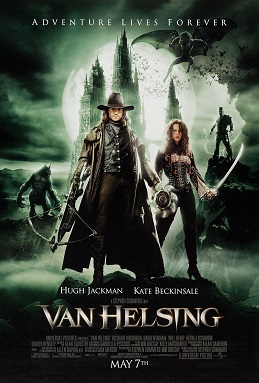
Van Helsing is a 2004 action horror film written and directed by Stephen Sommers. It stars Hugh Jackman as monster hunter Van Helsing and Kate Beckinsale as Anna Valerious. Van Helsing is both an homage and tribute to the Universal Horror Monster films from the 1930s and 1940s, of which Sommers is a fan.
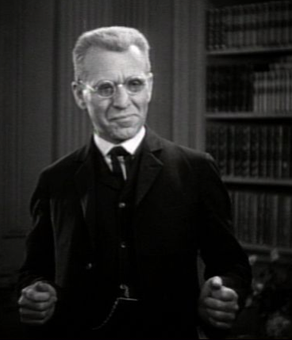
Professor Abraham Van Helsing is a fictional character from the 1897 gothic horror novel Dracula written by Bram Stoker. Van Helsing is a Dutch polymath doctor with a wide range of interests and accomplishments, partly attested by the string of letters that follows his name: "MD, D.Ph., D.Litt., etc.", indicating a wealth of experience, education and expertise. He is a doctor, professor, lawyer, philosopher, scientist, and metaphysic. The character is best known through many adaptations of the story as a vampire slayer, monster hunter and the arch-nemesis of Count Dracula, and the prototypical and the archetypical parapsychologist in subsequent works of paranormal fiction. Some later works tell new stories about Van Helsing, while others, such as Dracula (2020) and I Woke Up A Vampire (2023) have characters that are his descendants.

R. M. Renfield is a fictional character who appears in Bram Stoker's 1897 Gothic horror novel Dracula. He is Count Dracula's deranged, fanatically devoted servant and familiar, helping him in his plan to turn Mina Harker into a vampire in return for a continuous supply of insects to consume and the promise of immortality. Throughout the novel, he resides in an asylum, where he is treated by Dr. John Seward.

Dracula is a 1931 American pre-Code supernatural horror film directed and co-produced by Tod Browning from a screenplay written by Garrett Fort and starring Bela Lugosi in the title role. It is based on the 1924 stage play Dracula by Hamilton Deane and John L. Balderston, which in turn is adapted from the 1897 novel Dracula by Bram Stoker. Lugosi portrays Count Dracula, a vampire who emigrates from Transylvania to England and preys upon the blood of living victims, including a young man's fiancée.

Quincey P. Morris is a fictional character in Bram Stoker's 1897 gothic novel Dracula.

Vampire films have been a staple in world cinema since the era of silent films, so much so that the depiction of vampires in popular culture is strongly based upon their depiction in films throughout the years. The most popular cinematic adaptation of vampire fiction has been from Bram Stoker's 1897 novel Dracula, with over 170 versions to date. Running a distant second are adaptations of the 1872 novel Carmilla by Sheridan Le Fanu. By 2005, the Dracula character had been the subject of more films than any other fictional character except Sherlock Holmes.

The Satanic Rites of Dracula is a 1973 British horror film directed by Alan Gibson and produced by Hammer Film Productions. It is the eighth film in Hammer's Dracula series, and the seventh and final one to feature Christopher Lee as Dracula. The film was also the third to unite Peter Cushing as Van Helsing with Lee, following Dracula (1958) and Dracula A.D. 1972 (1972).

Jonathan Harker is a fictional character and one of the main protagonists of Bram Stoker's 1897 Gothic horror novel Dracula. An English solicitor, his journey to Transylvania and encounter with the vampire Count Dracula and his Brides at Castle Dracula constitutes the dramatic opening scenes in the novel and most of the film adaptations.
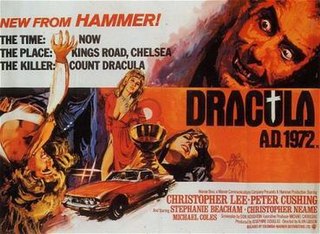
Dracula A.D. 1972 is a 1972 British horror film, directed by Alan Gibson and produced by Hammer Film Productions. It was written by Don Houghton and stars Christopher Lee, Peter Cushing and Stephanie Beacham. Unlike earlier films in Hammer's Dracula series, Dracula A.D. 1972 had a contemporary setting in an attempt to update the Dracula story for modern audiences. Dracula is brought back to life in modern London and preys on a group of young partygoers that includes the descendant of his nemesis, Van Helsing.

Blood of Dracula's Castle is a 1969 American horror cult B-movie directed by Al Adamson and starring John Carradine, Alexander D'Arcy, Paula Raymond, Robert Dix, Vicki Volante, and John Cardos. It was released by exploitation film specialists Crown International Pictures. Although his name was played up in the lurid ad campaign, John Carradine only played George the butler in this film, and not Count Dracula. DVD prints all suffer from extensive emulsion scratches.

Billy the Kid Versus Dracula is a 1966 American horror Western film directed by William Beaudine. The film is about Billy the Kid trying to save his fiancée from Dracula. The film was originally released as part of a double feature along with Jesse James Meets Frankenstein's Daughter in 1966. Both films were shot in eight days at Corriganville Movie Ranch and Paramount Studios in mid-1965; both were the final feature films of director Beaudine. The films were produced by television producer Carroll Case for Joseph E. Levine.
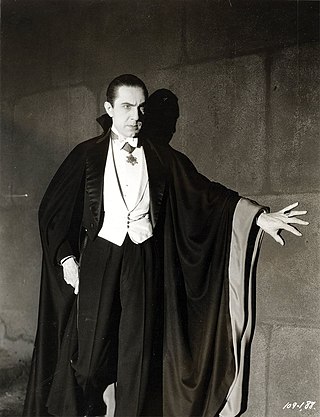
Count Dracula is the title character of Bram Stoker's 1897 gothic horror novel Dracula. He is considered the prototypical and archetypal vampire in subsequent works of fiction. Aspects of the character are believed by some to have been inspired by the 15th-century Wallachian prince Vlad the Impaler, who was also known as Vlad Dracula, and by Sir Henry Irving, an actor for whom Stoker was a personal assistant.

Dracula is a 1931 Spanish-language American horror film directed by George Melford. The film is based on both the novel Dracula by Bram Stoker and the play Dracula by Hamilton Deane and John L. Balderston. The film is about Renfield, who travels to Translyvania to visit Conde Drácula. He is drugged by the Count and becomes his minion. The two travel to England, where Drácula begins to seduce Lucía Weston as she becomes his first victim. This leads Professor Van Helsing to investigate, who confirms that Drácula is a vampire.

Dracula, also known as Bram Stoker's Dracula and Dan Curtis' Dracula, is a 1974 British made-for-television gothic horror film and adaptation of Bram Stoker's 1897 novel Dracula. It was written by Richard Matheson and directed by Dark Shadows creator Dan Curtis, with Jack Palance in the title role. It was the second collaboration for Curtis and Palance after the 1968 TV film The Strange Case of Dr. Jekyll and Mr. Hyde.
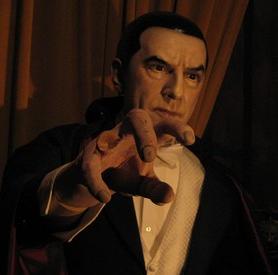
The character of Count Dracula from the 1897 novel Dracula by Bram Stoker, has remained popular over the years, and many forms of media have adopted the character in various forms. In their book Dracula in Visual Media, authors John Edgar Browning and Caroline Joan S. Picart declared that no other horror character or vampire has been emulated more times than Count Dracula. Most variations of Dracula across film, comics, television and documentaries predominantly explore the character of Dracula as he was first portrayed in film, with only a few adapting Stoker's original narrative more closely. These including borrowing the look of Count Dracula in both the Universal's series of Dracula and Hammer's series of Dracula, including include the characters clothing, mannerisms, physical features hair style and his motivations such as wanting to be in a home away from Europe.

Dracula is a stage play written by the Irish actor and playwright Hamilton Deane in 1924, then revised by the American writer John L. Balderston in 1927. It was the first authorized adaptation of Bram Stoker's 1897 novel Dracula. After touring in England, the original version of the play appeared at London's Little Theatre in July 1927, where it was seen by the American producer Horace Liveright. Liveright asked Balderston to revise the play for a Broadway production that opened at the Fulton Theatre in October 1927. This production starred Bela Lugosi in his first major English-speaking role.
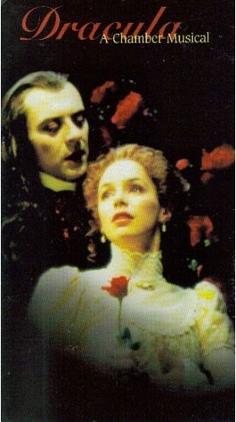
Dracula: A Chamber Musical is a 1997 Canadian musical adaptation of Bram Stoker's 1897 novel Dracula. The book and lyrics are by Richard Ouzounian and the music and orchestration are by Marek Norman. After premiering at the Neptune Theatre in Halifax, Nova Scotia, in 1997, Dracula in 1999 became the first Canadian musical to be staged at the Stratford Shakespeare Festival.
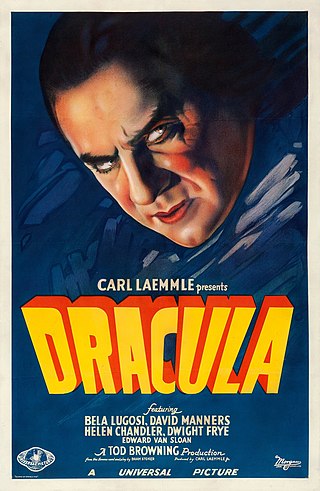
Dracula is a film series of horror films from Universal Pictures based on the 1897 novel Dracula by Bram Stoker and its 1927 play adaptation. The series is a loose collection of films, with historians stating that the films all reference characters, events or at least passing knowledge of the 1931 English-language production of Dracula, with historians noting that Dracula's Daughter and Son of Dracula are more closely related to the 1931 film while the character of Dracula would make smaller appearances in later films such as House of Frankenstein and House of Dracula. After Dracula's Daughter, the character of Dracula and other vampires in the series became more Americanized, starting with the release of Son of Dracula, and the later House of films. The character of Dracula appears in all the films outside of Dracula's Daughter, where he is portrayed by Bela Lugosi, Lon Chaney Jr., and John Carradine in the House of films.
Dracula is a British horror film series produced by Hammer Film Productions. The films are centered on Count Dracula, bringing with him a plague of vampirism, and the ensuing efforts of the heroic Van Helsing family to stop him. The original series of films consisted of nine installments, which starred iconic horror actors Christopher Lee and Peter Cushing as Count Dracula and Doctor Van Helsing, respectively. The series is part of the larger Hammer horror oeuvre.
















